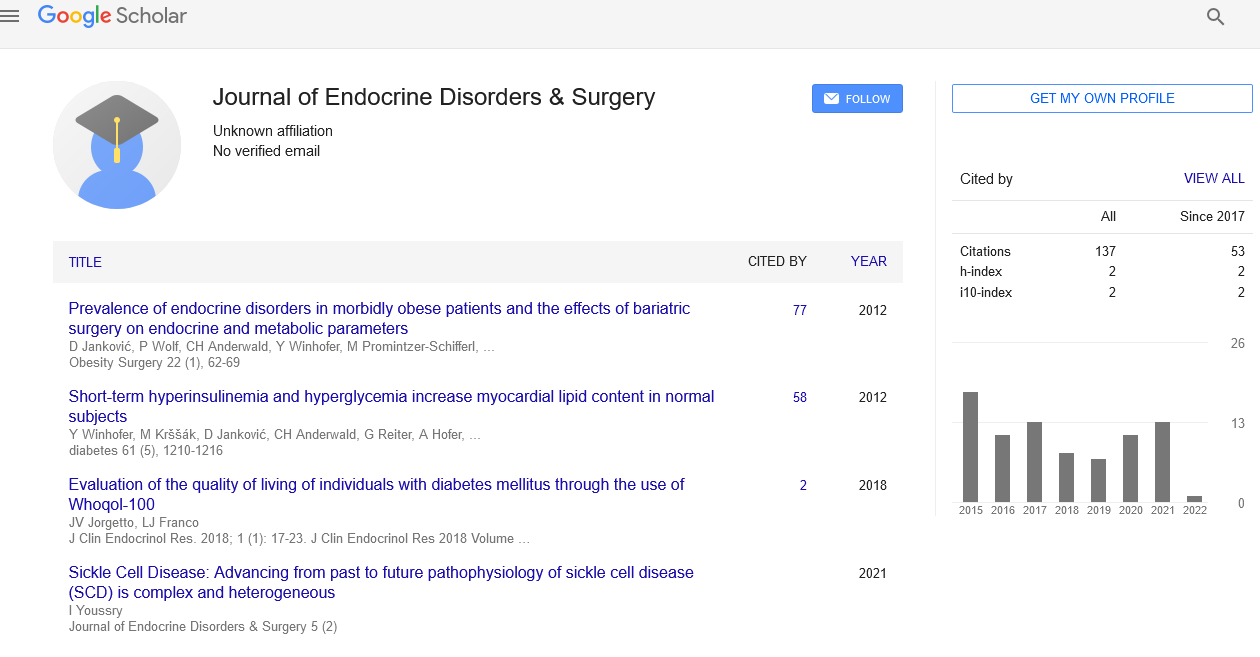Failure of Androgen
Received: 04-Dec-2022, Manuscript No. puljeds-23-6211; Editor assigned: 06-Dec-2022, Pre QC No. puljeds-23-6211 (PQ); Accepted Date: Dec 23, 2022; Reviewed: 10-Dec-2022 QC No. puljeds-23-6211 (Q); Revised: 12-Dec-2022, Manuscript No. puljeds-23-6211 (R); Published: 30-Dec-2022, DOI: 10.37532/puljeds.2022.6(6).07-08
Citation: James A. Failure of androgen. J. Endocr Disord Surg. 2022;6(6):07-08.
This open-access article is distributed under the terms of the Creative Commons Attribution Non-Commercial License (CC BY-NC) (http://creativecommons.org/licenses/by-nc/4.0/), which permits reuse, distribution and reproduction of the article, provided that the original work is properly cited and the reuse is restricted to noncommercial purposes. For commercial reuse, contact reprints@pulsus.com
Abstract
A hormonal problem called androgen deficiency is commonly seen in chronic illnesses with advanced stages. Blood amounts of androgen may drop as a result of the illness, as a cause, or as both. Low levels of androgen may indirectly impact the severity of the illness and may exacerbate common symptoms like fatigue or muscle weakness in heart failure. A novel treatment option for heart failure symptoms has recently been proposed: androgen replacement therapy. Placebo-controlled pilot studies have revealed a modest improvement in physical performance. However, testosterone replacement in elderly patients carries some risks, and it is unknown what the benefit-risk ratio of this adjunctive therapy.
Keywords
Androgen; Cancer
Introduction
Androgen restriction therapy is an important component of treatment for prostate cancer (. Some medications in this family function by lowering testosterone levels by reducing luteinizing hormone or follicle-stimulating hormone levels. As an illustration, both Gonadotropin Receptor Hormone (GnRH) agonists (such as leuprolide, goserelin, and triptorelin) and GnRH inhibitors (such as degarelix) lower the levels of luteinizing hormone and FollicleStimulating Hormone (FSH), which lowers the levels of testosterone. Other drugs in this class, such as abiraterone, an inhibitor of the adrenal androgen receptor, and enzalutamide, an inhibitor of the direct androgen receptor, operate downstream to decrease testosterone activity. GnRH agonists and antagonists are used with the intention of curing high risk non metastatic prostate cancer in men and as part of routine therapy in men with metastatic prostate cancer.
Abiraterone is increasingly being used in conjunction with GnRH agonists to increase longevity among men with stage IV prostate cancer. Since many of the risk factors for prostate cancer, such as age, smoking, diet, and obesity, are also risk factors for cardiovascular disease, it is crucial to understand how ADT treatment affects cardiovascular risk. However, the specific effects of ADT on cardiovascular risk are still unknown.
It has been demonstrated that using Androgen Deprivation Therapy (ADT) to treat advanced prostate cancer slows the disease's clinical development. However, this therapy's suppression of testosterone may result in a condition known as hypogonadism, which can have a negative impact on renal function, increasing the possibility that Acute Kidney Injury (AKI) could result from ADT induced hypogonadism. Serious adverse events can happen while receiving ADT, despite evidence that it slows the development of prostate cancer. ADT, in particular, lowers testosterone levels, causing a condition known as hypogonadal, which is characterised by metabolic changes like dyslipidemia, hyperglycemia, and an increase in adipose mass. By enlarging and stiffening the interstitial tubular membrane, hyperglycemia and dyslipidemia can impair glomerular function in the context of the renal system. Additionally, ADT may counteract the vasodilating effects of testosterone on renal vessels in addition to causing an oestrogen deficiency, which can impair renal tubular function, by reducing testosterone to castration levels. The use of ADT may therefore raise the risk of acute kidney injury through these mechanisms.
The most prevalent malignancy and the second leading cause of cancer-related deaths among males in developed nations is Prostate Cancer (PCa). The prevalence of PCa has increased over the past few decades. Ageing populations, obesity brought on by "western" dietary practices, and rising PSA testing usage are all contributing factors to this increase. Androgens are necessary for the survival and development of prostate cells, whether they are healthy or cancerous. As a result, Androgen Deprivation Therapy (ADT), also known as hormone therapy by some medical professionals, continues to be the cornerstone of PCa care. ADT refers to surgical (bilateral orchiectomy) or chemical (pharmaceutical) treatments that lower serum testosterone levels or block the androgen receptor. Flutamide, enzalutamide, and apalutamide (the modern derivatives) are examples of antiandrogens that are used in conjunction with chemical or surgical castration but are not deemed ADT on their own. As the testes are the primary source of circulating androgens (producing nearly 95% of the total), ADT was originally accomplished by orchiectomy; the remaining 5% are produced by the adrenal glands.
The most popular type of modern ADT is Luteinizing HormoneReleasing Hormone (LHRH) agonists, which are typically prescribed when patients are either diagnosed with advanced (incurable) disease at presentation or with recurrent cancer following first-line treatment (such as radical prostatectomy or radiation therapy) for local disease. The Luteinizing Hormone-Releasing Hormone (LHRH) agonists provided real medical castration, but when first used, they caused clinical problems due to a spike in testosterone and a flare-up of tumours. The initial stimulation of LHRH receptors is thought to be the source of the "flare" phenomenon, which is characterised by an increase in serum testosterone levels. Antiandrogens were thought to help with this clinical problem by preventing the stimulation impact at the androgen receptor level. Contrary to early predictions, the combination of LHRH agonists and antiandrogens did not increase cancer-specific survival. The major reasons why the combined treatment never became the standard of care were thought to be the costs, inconvenience of therapy, additional toxicity, and the development of the saturation model.





